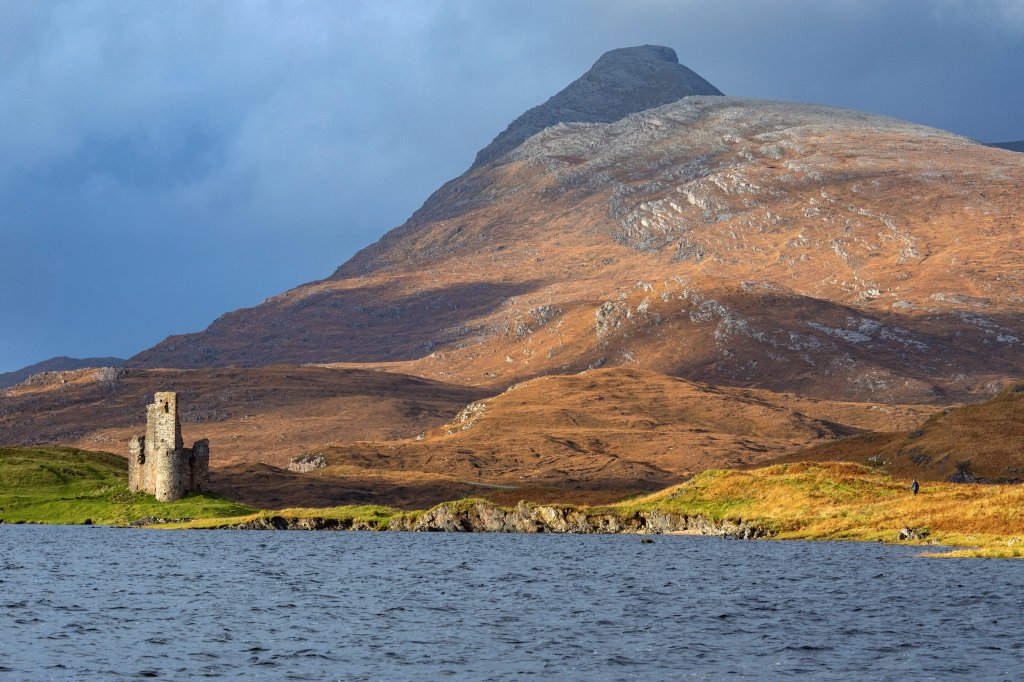Stac Pollaidh
Stac Pollaidh: Scotland’s Wild Pinnacle
Drive through the rugged heart of Assynt and one mountain will pull your eyes away from everything else - Stac Pollaidh. It isn’t the tallest peak in the Highlands, not by a long shot. At just 612 metres, it’s almost modest compared to the surrounding giants like Suilven or Cul Mor. But height is not what makes Stac Pollaidh remarkable. It’s the silhouette: a serrated ridge of crumbling pinnacles, a spine of sandstone that looks like it’s been clawed by the gods. Some call it the “Scottish Monument Valley”, others simply say it’s the most fun mountain to climb in the northwest.
This isn’t a mountain that hides itself away. From the roadside you can see it standing proud, a sculpted mass of Torridonian sandstone carved by ice and wind. Even on grey days, the ridgeline has presence. On clear ones, it’s irresistible.
A Hill Walk with a Punch
The beauty of Stac Pollaidh is that you don’t need to be a hardened mountaineer to enjoy it. The circular path that loops around the mountain was built in the 1990s to ease erosion and make access easier. It means that walkers of decent fitness can climb up, wander around its flanks, and drink in the views without needing ropes or serious gear.
The standard route starts from the car park just off the A835, south of Lochinver. The path is steep from the beginning, zig-zagging its way up through heather and boggy moorland. It doesn’t take long before you’re gaining height, and with every pause to catch your breath the landscape around you gets bigger and bolder. Lochs sparkle below, rivers cut silver lines through the moor, and mountains rise in all directions.
It’s about an hour or so to reach the ridge, depending on your pace. From there, things get playful. The ridge of Stac Pollaidh runs east to west, with pinnacles sticking up like broken teeth. You can scramble along parts of it if you’re confident, but most walkers are content to reach the eastern summit - a fine perch with panoramic views. The true western summit requires some proper scrambling and exposure, so it’s best left for the experienced.
The Reward: Views That Stop You Dead
Stand on Stac Pollaidh on a clear day and you’ll feel like you’ve stepped into a painting. To the north lies the mighty bulk of Suilven, one of Scotland’s most iconic mountains. Beyond that, the jagged outline of Canisp and the graceful dome of Quinag. To the south, Ben More Coigach stretches out towards the coast, with the Summer Isles floating on the horizon. Loch Lurgainn gleams directly below, curling around the base of the hill like a mirror.
What makes the view so mesmerising is the sheer space of it all. The landscape of Assynt and Inverpolly is ancient, wild, and oddly shaped. There are no neat ranges of mountains here, just isolated peaks scattered across moorland, like geological islands rising from a sea of lochs. Stac Pollaidh gives you the perfect vantage point to make sense of it all.
And then there’s the ridge itself. Those sandstone pinnacles glow red and gold in evening light, casting long shadows across the slopes. Photographers love this mountain for obvious reasons - it’s dramatic from every angle.
A Mountain with Character
Part of the charm of Stac Pollaidh is that it’s approachable yet dramatic. You can climb it in half a day, making it one of the shortest hikes in the Highlands. Many visitors tackle it as a morning walk before heading to Achiltibuie for seafood or down the road towards Ullapool.
But don’t be fooled by its modest height. The weather here can change in a heartbeat. Mist can roll in and hide the ridge in minutes, winds can whip up, and rain can turn the sandstone slick. Sensible gear such as waterproofs, sturdy boots, and a map are essential.
The name itself adds to the sense of mystery. Stac Pollaidh (often pronounced “Stack Polly”) comes from Gaelic: Stac meaning a stack or peak, and Pollaidh possibly linked to the nearby village of Polbain. Like many Gaelic place names, there are layers of history in it. Locals often chuckle when visitors wrestle with the pronunciation.
For Walkers and Dreamers
Not everyone climbs Stac Pollaidh. For some, it’s enough just to stop at one of the laybys on the roadside and gaze at it. The mountain has that kind of pull. Artists sketch it, writers try to capture it, photographers chase the perfect light.
There’s a wild romance to it. Unlike Ben Nevis or Cairn Gorm, which feel like challenges to conquer, Stac Pollaidh feels playful. It’s a mountain to enjoy, to scramble on, to laugh with friends as you pick your way around the ridge. It’s less about reaching the summit and more about savouring the journey.
A Perfect Introduction to the Highlands
For travellers exploring the North Coast 500 or heading through Assynt, Stac Pollaidh is the perfect introduction to Highland walking. It’s short, it’s spectacular, and it leaves you buzzing for more. Climb it in the morning, spend the afternoon at Achmelvich Beach, and you’ll have the kind of day that stays with you forever.
Even seasoned walkers love it. There’s something addictive about that ridgeline. Once you’ve seen it, you want to go back, maybe to catch the sunrise, maybe to try the scramble to the true summit.
Whilst isn’t the highest peak, it is unforgettable. A hill that looks like a fortress, a playground of pinnacles, a window onto some of the most dramatic scenery in Scotland. Whether you climb to the ridge, scramble the spires, or simply watch the mountain change colours from the roadside, you’ll understand why people rave about it.
In a land full of extraordinary landscapes, Stac Pollaidh still manages to steal the show.
Magnificent Stac Pollaidh views
The surrounding Loch Assynt





